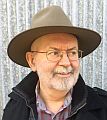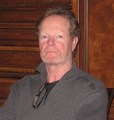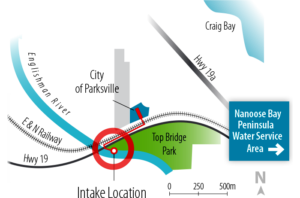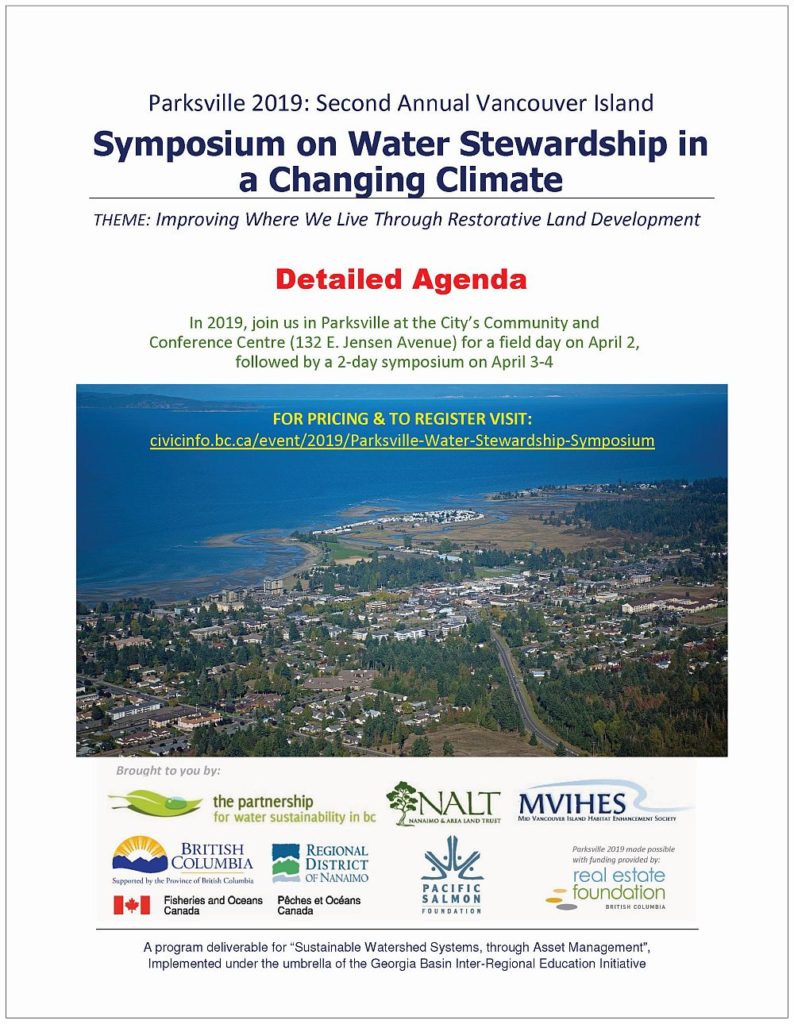MODULE B – DAY ONE – PARKSVILLE 2019: A Panel & Town-Hall Session on “Watershed Health and You” features the Englishman River integrated system, to demonstrate that what happens on the land in a watershed (and in its tributary creeksheds) matters to streams
Note to Reader:
Click on PARKSVILLE SYMPOSIUM AGENDA to download a package that elaborates on the presentation topics in each of the four modules that comprise the program on each symposium day. Parksville 2019 is a call to action. Read together, the set of abstracts create a seamless storyline that is designed to inform delegates so that they will know what to expect on April 3-4 when they convene in Parksville.

Englishman River Watershed
MODULE B: Panel & Town-Hall Session: Watershed Health and You
“The Englishman River ‘big picture’ story (endangered river, regional water source, Shelly Creek restoration) provides the backdrop for developing a shared understanding of what a Whole-System approach looks like, and what it would mean to reconnect hydrology and ecology,” states Peter Law, President of the Mid Vancouver Island Habitat Enhancement Society (MVIHES).
“What happens on the land in a watershed (and in its tributary creeksheds) matters to streams, especially when the changing climate is altering the seasonal water balance. The Englishman River storyline provides local context for the Whole-System Approach to protection of hydrologic function under current and future conditions.”
Two-Part Format
“In their prepared remarks, panelists will describe elements of the Englishman River story to prime the audience for town-hall interaction,” continues Peter Law.
The town-hall is the heart of the symposium program. The spotlight is on citizen science, and in particular the catalyst role MVIHES plays. A 5-person team, including Peter Law, will prime the audience with 5-minute vignettes.
“Panelists will engage with the audience on the value of ‘citizen science’ and how it can be leveraged to achieve two complementary objectives: educate the local community (public); and inform alignment of provincial, regional and local actions so that they truly do result in sustainable stream restoration,” explains Peter Law.
“The desired outcome is that the audience will understand why the Englishman River Watershed is an integrated system, and will be better informed to champion the Whole-System Approach in the creeksheds where they live.”
Ignite Format for Storytelling
“Each panel member has 5 minutes to tell his or her part of the panel storyline. The objective in ‘presenting at them’ is to prime the audience for town-hall interaction. Hence, the panel presentations must be streamlined and past-paced,” states Kim Stephens, Executive Director, Partnership for Water Sustainability in British Columbia.
 “We want the audience to be champing at the bit to have a conversation to learn more. So, we are asking panel members to apply the Ignite format. The result will be a fast and fun set of presentations.
“We want the audience to be champing at the bit to have a conversation to learn more. So, we are asking panel members to apply the Ignite format. The result will be a fast and fun set of presentations.
“Ignite is a presentation format that’s simpler than Pecha Kucha but longer than lightening talks. In Ignite each speakers gets 5 minutes, and must use 20 slides with each slide advancing automatically after 15 seconds, forcing speakers to get to the point, fast.
“Having slides that automate seems mad, and in a way it is, but the surprise is that for most speakers it forces them to be far more concise and thoughtful than they would in any other format.
“The one refinement that we are making is to specify that each speaker can use up to 20 slides. This gives some flexibility. But the 5 minute limit still applies.”

Englishman River / Shelly Creek: Over time, MVIHES has morphed from “Stewards of the Englishman River Recovery Plan” to “Stewards of the Watershed”
In the 1990s, the Recovery Plan was the first implemented by the Pacific Salmon Endowment Fund. MVIHES was formed to represent the community and facilitate implementation of stream restoration projects. MVIHES mission has since evolved to connect people to their landscape through education, with a focus on Shelly Creek, one of five tributaries. It is the last fish-bearing creek flowing through Parksville. Survival of Coho salmon in the Englishman depends on Shelly!
Historical Context
In 1999 the Englishman River was first declared to be one of the most endangered rivers in BC. Extinction of the fisheries resource was viewed as a very real possibility. This was the catalyst for action. It resulted in two transformational outcomes: implementation of the Englishman River Watershed Recovery Plan (2001); and creation of the Mid Vancouver Island Habitat Enhancement Society (MVIHES).
 “In 2006, the BC Conservation Foundation (BCCF) received approval from the Living Rivers Trust Fund Advisory Group for a multi-year Living Rivers – Georgia Basin/Vancouver Island business plan that focuses on fish and water sustainability projects in high priority Georgia Basin and Vancouver Island watersheds,” reports Craig Wightman, BCCF Senior Fisheries Biologist.
“In 2006, the BC Conservation Foundation (BCCF) received approval from the Living Rivers Trust Fund Advisory Group for a multi-year Living Rivers – Georgia Basin/Vancouver Island business plan that focuses on fish and water sustainability projects in high priority Georgia Basin and Vancouver Island watersheds,” reports Craig Wightman, BCCF Senior Fisheries Biologist.
“Investments from this program in the Englishman Watershed have been substantial to date, including construction of log jam fish rearing structures; side-channel improvements; fish abundance and stream flow monitoring; headwater lake storage feasibility; estuary biophysical inventory and restoration planning; public education about the value of water conservation; and, applied groundwater research.”
A Voice for the Community
Over time, MVIHES has morphed from Stewards of the Plan to Stewards of the Watershed. Beginning in 2011, the MVIHES action plan has concentrated on Shelly Creek. One of five Englishman River tributaries, it is the last fish-bearing creek flowing through the City of Parksville.
 “MVIHES represented the community in the Watershed Recovery Plan implementation process during the period 2001 through 2008,” explains Peter Law, MVIHES vice-president. “There were substantial financial investments in stream restoration projects to enhance salmon and steelhead habitat. MVIHES was the community voice, and its eyes and ears.”
“MVIHES represented the community in the Watershed Recovery Plan implementation process during the period 2001 through 2008,” explains Peter Law, MVIHES vice-president. “There were substantial financial investments in stream restoration projects to enhance salmon and steelhead habitat. MVIHES was the community voice, and its eyes and ears.”
“As time moved on, priorities changed, and the role of MVIHES was refocussed into ‘monitoring streams’ to ensure watershed health. This meant getting the community involved by connecting people to their landscape through the Watershed Health and You initiative.”

Englishman River Water Service (ERWS): A Balancing Act – Regional Bulk Water Supply Needs & Environmental Flow Requirements to Sustain Aquatic Resources
The ERWS is a joint venture between the City of Parksville and the RDN. It comprises the 20-yr old Arrowsmith Dam, a new river intake (2018) and a water treatment facility (2019). System operation is guided by this statement: “An environmentally sensitive use of water to improve fish habitat and domestic water supply”. The impact of wetter winters and drier summers on the seasonal water balance creates operational challenges in sustaining environmental flows.
River Intake
 Using a sustainable approach weighing environmental, financial and social factors and in consultation with Department of Fisheries and Oceans, health authorities, provincial fisheries and regulators, the best location for a river intake as approved by the province is just above Highway 19 on the right bank in Top Bridge Park. The intake is a river side inlet structure.
Using a sustainable approach weighing environmental, financial and social factors and in consultation with Department of Fisheries and Oceans, health authorities, provincial fisheries and regulators, the best location for a river intake as approved by the province is just above Highway 19 on the right bank in Top Bridge Park. The intake is a river side inlet structure.
Approximately 50% of the live storage volume behind the Arrowsmith Dam is provided for release of water during low natural river flows, to improve fisheries flow in the downstream reach of the Englishman River.

Groundwater & Surface Water Interaction in the Englishman River Watershed: One Water – Always Moving
‘Flux’ is a core concept because an aquifer is not an underground lake. Water is always moving. Community involvement in a monitoring program was a foundation piece, and one of several innovations, for characterizing surface and groundwater interaction in the Englishman system – e.g. the connections between land, aquifers and river are illustrated using “butterfly” images.
Characterizing Aquifers
Because he looked at groundwater differently in the Englishman River, Dr. Gilles Wendling has advanced the science and he has developed a practical application of water balance thinking. His contributions to science-based understanding extend beyond the technical and into the communication and education realm. His work provides a bridge between rainfall and stream health.
 “Characterizing aquifers is a complex and costly exercise because you need wells in order to reach aquifers and to monitor the depth and fluctuation of the level of the water table,” states Dr. Wendling. “The approach that we took with MVIHES in the Englishman River Watershed was to involve the community.”
“Characterizing aquifers is a complex and costly exercise because you need wells in order to reach aquifers and to monitor the depth and fluctuation of the level of the water table,” states Dr. Wendling. “The approach that we took with MVIHES in the Englishman River Watershed was to involve the community.”
Dr. Wendling emphasizes that time is a critically important dimension in maintaining the water balance. Also, that water is always moving. These are fundamental concepts, yet are not always well understood.

Sustainable Forest Management in the Englishman River Watershed: Maintaining Hydrological Balance is Critical for Success
Over 80% of the Englishman River watershed is dedicated to forest management. Applying a landscape level approach makes a working forest work for multiple values. Hydrology and ecology values are managed through conservation agreements, land sales, and cooperation with researchers and communities. A guiding objective is to “keep sediment out of streams”.
Mosaic Forest Management
On November 1st, 2018, British Columbia Investment Management Corporation (BCI), the Public Sector Pension Investment Board (PSP Investments), and Alberta Investment Management Corporation (AIMCo) affiliated their long-term timber investments, TimberWest Forest Corporation and Island Timberlands Limited Partnership.
Mosaic Forest Management is responsible for managing the Affiliation and provides a range of services to TimberWest and Island Timberlands from harvest planning to operations, marketing and sales.
“The forest is the foundation of TimberWest’s and Island Timberland’s businesses, and maintaining ecological balance is critical for success,” states Domenico Iannidinardo, Vice-President, Forest & Sustainability and Chief Forester for Mosaic.
“We work hard to ensure our international reputation as an environmentally-responsible supplier of BC coastal timber. Our commitment to environmental stewardship is unwavering and is at the heart of our business.”
Surface Water Quality Trend Analysis: Linking Water Quality Data Results with Land Use Factors
Through the efforts of stewardship volunteers, the RDN’s Community Watershed Monitoring Network has successfully completed 7+ years of monitoring surface water quality. A recent study has analyzed the data region-wide, modelling land use factors and their connection to water quality results, including for the Englishman River.
Community Watershed Monitoring Network
Started in 2011, the Community Watershed Monitoring Network is a partnership between the Regional District of Nanaimo (RDN) and its Drinking Water and Watershed Protection (DWWP) program, the Ministry of the Environment, Island Timberlands LP, and many community watershed stewardship groups in our region.
The RDN provides the equipment and works with the Ministry to complete annual training and data analysis. The Ministry contributes expertise in water quality testing, deciphering gathered data and guidance in program direction.
Island Timberlands sponsors the lab analysis costs for Quality Assurance and Quality Control, loans volunteers’ safety gear and provides access to the upper watersheds.
Dedicated community groups donate their time, attending annual training sessions, calibrating equipment and getting out on their local streams to collect water quality data.
To Learn More:
Download PARKSVILLE SYMPOSIUM AGENDA.
To read the consolidated story of all four modules on Day One, click on SUSTAINABLE STREAM RESTORATION: Parksville 2019 Symposium organizing committee releases the Detailed Agenda for Day One (April 3) – “Getting It Right by Applying the Whole-System Approach”


